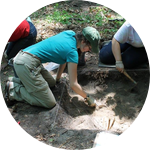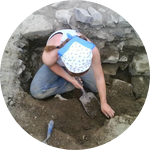About This Project
What will you leave behind when you die? A diary? A blog? A "Remembering (name here)" Facebook page? What if you couldn't read or write? After the British occupation of Ireland, Catholics weren't allowed to go to school, and most never learned to write. A story was told of their superb health, but was that story's true? How can one be healthy when starving? Your contribution will help them tell their own stories through their bones in a skeletal analysis of health before the Famine.
Ask the Scientists
Join The DiscussionWhat is the context of this research?
The Great Famine marks one of the most significant events in Irish history (Geber 2015:2). While it is often assumed that these events kill indiscriminately, recent studies in bioarchaeology have shown that these disasters are selective (DeWitte 2010, 2014), killing individuals who are most frail. It is therefore possible that underlying health prior to the Famine could have contributed to the catastrophic mortality. Between the late medieval (AD 1250-1550) and post-medieval periods (AD 1550-1880), England intensified its colonization efforts in Ireland to prevent the spread of Catholicism, a perceived threat to the British monarchy. Such efforts could have resulted in adverse health outcomes for the Irish, making them more vulnerable to death.
What is the significance of this project?
My research challenges the assumption that Irish health improved in the post-medieval period (e.g., Clark and Kelly 2010:110, Novak et al. 2017) despite endemic destitution and increasing reliance on the potato. Sinclair (1828), for example, writes that potatoes were a “blessing” and that they had greatly improved the condition of the poor. This project will contribute to Irish history by testing the veracity of such statements. Moreover, if it is found that health declined during this period, this would suggest that underlying population frailty contributed to death during the Famine because poor health in one generation can contribute to poor health in subsequent generations (Gowland, 2015), ultimately increasing risk of death when faced with famine.
What are the goals of the project?
I am testing the veracity of modern narratives and contemporary accounts of Irish health by conducting a bioarchaeological analysis of stress lines in teeth (LEH) and age-at-death in Irish skeletons. Both childhood stress and younger age-at-death are associated with poorer health. I expect that health will have declined during the post-medieval period and that the individuals from this period will exhibit a greater number of LEH and a lower age-at-death. I will test this hypothesis by making casts of teeth and bringing the casts back to the US to examine them under a microscope. This will allow me to count the number of stress lines in the teeth. While I am in Ireland, I will evaluate the age of skeletons in both samples.
Budget
Your contribution will help me pay for my airfare to and from Ireland, which is required so that I can examine about 400 skeletons at the National Museum. University regulations require me to have supplementary health insurance, which is $3 a day for 40 weeks. Finally, your contribution will help me buy materials to make impressions and casts of their teeth. This will allow me to count stress lines, called LEH, which form during childhood when a child is sick or poorly nourished. These illnesses could have affected adult health, making the population more vulnerable to death during the Famine.
Endorsed by
 Project Timeline
Project Timeline
I will begin skeletal analysis on August 1st in Dublin, Ireland and will stay until April. During this time, I will make observations and take dental casts of 338 skeletons and conduct research in the National Archives. Upon my return to the US in April of 2019, I will examine casts of the teeth under a measuring microscope to count the number of stress lines per individual and compare these between populations. I will defend my dissertation in 2020.
Apr 27, 2018
Project Launched
Aug 01, 2018
Travel to Swords, Co. Dublin, Ireland for research at the Collections Resource Centre
Apr 01, 2019
Return to the US to begin microscopic analysis and continue writing
May 01, 2020
Defend dissertation
Dec 01, 2020
Publish results in academic journal
Meet the Team
Melissa Clark
I am a bioarchaeologist and PhD candidate at The Ohio State University. Every summer I have worked on an archaeology site in Ireland since 2010. I earned two bachelor's degrees at OSU in 2013, one in Anthropology with research distinction, and the other in International Studies. In 2015 I earned my MSc. in Osteology and Paleopathology from the University of Bradford, UK. When I'm not excavating in Ireland, I am at home in the US mentoring undergraduate students and guiding them through their own independent research projects. My research interests include dental anthropology, bioarchaeology, forensic anthropology, and education pedagogy. I hope to be a professor so that I can continue to help young women and other underrepresented groups in academia follow their dreams, like my advisor has done for me.
Project Backers
- 7Backers
- 14%Funded
- $276Total Donations
- $39.43Average Donation

